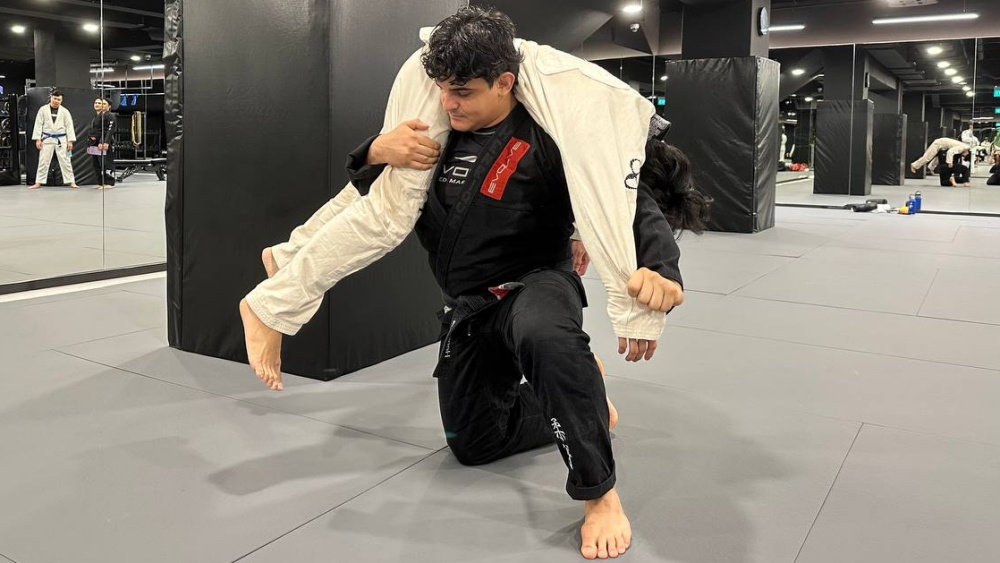A good leg lock game consists of understanding the basic concepts of leg entanglement, attack, and defense. A BJJ practitioner must be able to assess which approach to use depending on body position. This means that you must have several attacks to choose from to be effective. This is where the toe hold comes in.
The toe hold is one of the venerable leg attacks in Brazilian Jiu-Jitsu. It is characterized by using a figure 4 grip on an opponent’s foot. The leverage generated from this configuration is so impressive that it can deal massive damage to the foot; it can sometimes damage the knee as well. Today we’ll talk about the toe hold and why it is such a great technique to learn.
What Is The Toe Hold?
As mentioned above, the toe hold is characterized by isolating a leg and doing a figure 4 grip on the foot. You start by holding the end of your opponent’s foot with one hand, then loop your other hand under his shin and grab your other arm near the wrist. This should sound familiar to you because this is the same arm configuration as the kimura lock. The finishing mechanics of the toe hold is similar to the kimura’s as well. You use the figure 4 grip to torque the foot in a twisting motion. This movement hyperextends the ankle’s ligaments and can cause tears along the foot if given enough pressure.
Typically, the toe hold can be used as an intermediary submission after the ankle lock. The toe hold is usually applied if you are at an angle relative to your opponent’s foot. This means that you can chain these 2 submission attacks as your opponent scrambles to escape. Alternatively, you can also use the kneebar in conjunction with the toe hold. Try using these attacks in combination, and you’ll be surprised at how intuitive it is to flow from one attack to the next.
History Of The Toe Hold
It’s been called a variety of things in Portuguese throughout the years, including mata leo no pé, americana no pé, and pé de vaca. The toe hold gained notoriety in the 70s, primarily to BJJ legend Rolls Gracie, who defied the Gracie family custom by advocating the usage of leg locks.
Leg locks back then were unfortunately frowned upon and were deemed as a cheap way to win. But now, with the explosion of the no-gi game, leg locks such as the toe hold are back in the limelight, and more and more grapplers are adding these techniques to their overall game.
A Versatile Leg Based Attack
What makes the toe hold such a useful submission is that it can not only be used as a move to finish a match, it can also lead to transitions to improve position, as well as to other leg-based submissions. While it also requires some form of leg entanglement (ashi garami) to be sucesssful, you can also threaten the toe hold from unusual positions like the top half guard. All you need is clearance to grab the end of the foot, and the threat of the toe hold is there!
Is the Toe Hold Effective?
The toe hold can be a nasty submission, and the pain of the hold is very sharp. The foot is vulnerable to twisting movements as ligaments can tear if the joint is hyperextended. This is why a twisted ankle can be so painful. Now imagine a trained person grabbing your foot and torquing it where it’s not supposed to go!
Here is a great video where Professor Gustavo Gasperin and Dr. Mike Piekarski discuss the science of the toe hold. Notice that Dr. Piekarski mentions that ligaments vulnerable to the toe hold have fewer sense receptors. This means that you may not feel a sharp pain until it’s too late. This can, of course, depend from person to person. To be safe, it’s best to be cautious so the risk of injury can be lessened.
Having said this, please take note that all submission attacks are not to be taken lightly. This is why tapping early and often is an important lesson to learn in BJJ. This is especially important for beginner and intermediate-level practitioners. Start slow and learn the mechanics without resistance. Gradually increase resistance as you and your partner improve.
Tips on Training
Years of focused drilling and sparring are required to develop a good leg game. Because leg locks generally start from the bottom, it is critical that you must have a decent understanding of guards and leg entanglements. Like they say, “Position before submission” – the same mantra applies to leg locks as well. Admittedly, learning leg attacks will not be accessible at first. However, it will become second nature the more you study and drill the positions. After months of diligent practice, you’ll be amazed at how natural it will become.
Final Thoughts
If you have to choose a select number of techniques to build a comprehensive leg lock game, the toe hold is undoubtedly a must-have. It is a viable option and can be applied in many situations. You can see the toe hold even in world-class competitions such as the ADCC.
It is a fundamentally easy technique to learn, but the many setups, tactics, and game plans surrounding the toe hold can mean years and years of intense study. It is recommended to build a core game based on your best techniques to ensure that you remain focused on these attacks so that your understanding of the nuances will be as sharp as possible. Whatever your game is, learning leg-based submissions such as the toe hold can only boost your game to greater heights!
You may also like:

















